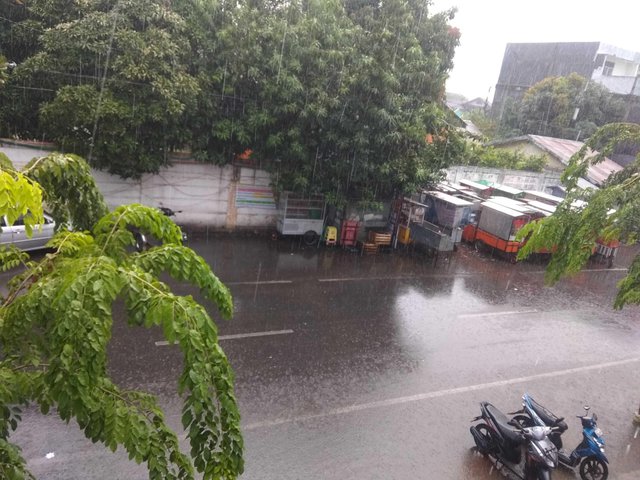rain
 Rain is a liquid precipitation, in contrast to non-liquid precipitation such as snow, ice cubes and slit. Rain requires the presence of a thick layer of atmosphere to meet temperatures above the melting point of ice near and above the Earth's surface. On Earth, rain is the process of condensing water vapor in the atmosphere into a grain that is heavy enough to fall and usually arrives on land. Two processes that may occur together can push the air increasingly saturated before the rain, which is air cooling or the addition of water vapor into the air.Virga is precipitation that falls to Earth but evaporates before reaching land; this is one way of saturation air. Precipitation is formed through a collision between water grains or ice crystals with clouds. Raindrops have a variety of sizes ranging from precise, like pancakes (large grains), to small balls (small grains).
Rain is a liquid precipitation, in contrast to non-liquid precipitation such as snow, ice cubes and slit. Rain requires the presence of a thick layer of atmosphere to meet temperatures above the melting point of ice near and above the Earth's surface. On Earth, rain is the process of condensing water vapor in the atmosphere into a grain that is heavy enough to fall and usually arrives on land. Two processes that may occur together can push the air increasingly saturated before the rain, which is air cooling or the addition of water vapor into the air.Virga is precipitation that falls to Earth but evaporates before reaching land; this is one way of saturation air. Precipitation is formed through a collision between water grains or ice crystals with clouds. Raindrops have a variety of sizes ranging from precise, like pancakes (large grains), to small balls (small grains).
The humidity that moves along the three-dimensional temperature and humidity difference zone called the weather front is the main method in making rain. If at that moment there is enough moisture and upward movement, the rain will fall from a convective cloud (cloud with a strong upward motion) like a cumulonimbus (thunderstorm) that can accumulate into a narrow rainbreak. In mountainous areas, heavy rainfall can occur if the upper flow of the valley rises at the top of the surface wind at altitudes that force moist air to condense and fall as rain along the side of the mountains. On the underside of the mountain breeze, desert climates can occur due to the dry air resulting from the flow of the valleys that leads to warming and drying of air masses. The movement of monsoon trumps, or intertropical convergence zones, brings the rainy season to a savanna climate. Rain is the main source of fresh water in most parts of the world, providing conditions suitable for ecosystem diversity, as well as water for hydroelectric power generation and irrigation of fields. Rainfall is calculated using a rain gauge. The amount of rainfall is actively calculated by passive and weather radar by weather satellites.
The impacts of urban hot islands encourage increased rainfall in numbers and intensity under the urban winds. Global warming also leads to changes in rain patterns around the world, including the rainy atmosphere in eastern North America and the dry atmosphere of the tropics. Rain is a major component of the water cycle and the primary provider of freshwater on the planet. The average annual global rainfall is 990 milimetres (39 in). Clustering systems such as the Köppen climate system group use annual mean rainfall to help differentiate climatic areas. Antarctica is the driest continent on Earth. In other areas, rain has also been down with the content of methane, iron, fluorescent, and sulfur. 
Thats alot of rain, we get alot in Georgia too.